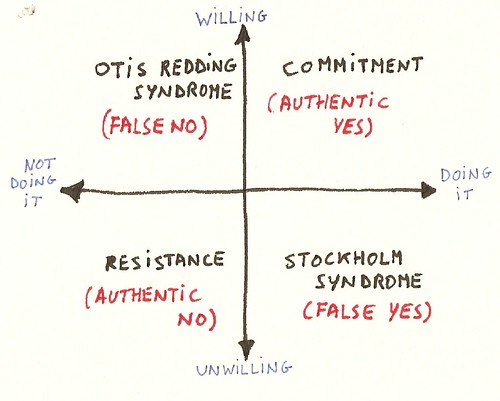The number one behavior you come across in the majority of the organizational change programs is never the open ‘in your face’ resistance. In fact, resistance is only 1 out of 4 possible reactions; but it takes a resistance map to see it.
The Real Meaning of Resistance
This week’s post is a small reminder of something I blogged about before: THANK GOD FOR RESISTANCE! For instance, in physics, resistance refers to the force that opposes motion. Next to that, the resistance of a material against an external influence, the resistance of a human body against a disease, and even the resistance in the Second World War are uses of the term that describe quality, health and guts; three terms that I would label as positive.
So here is my claim to re-label the term ‘resistance’ in our area of expertise as well. I want to create awareness of the fact that resistance means:
- People care about the stuff;
- People are brave enough to tell you they disagree;
- People have a backbone and guts;
- People are being authentic.
The Map Of Resistance
Bear with me, as I will build a diagnostic instrument; a “Resistance Map”. But first, we need a frame of reference to clarify what we are talking about. And it’s a simple one: WHAT I WANT versus WHAT I DO. In other words, we make a difference between the intention we have inside of us (INTENT – ‘What I want’) and the behavior that we demonstrate on the outside (BEHAVIOR – ‘What I do’).
This is the basic setup: The vertical axis displays intent and the horizontal axis shows the behavior that we demonstrate on the outside. As a result there are four quadrants:

The Four Quadrants
- Commitment: what happens when your intention is willing and your behavior follows your intentions. Let’s say this is an authentic ‘yes’;
- Resistance: what happens when your intention is unwilling and when it is in resonance with your behavior. In his book on Flawless Consulting, Peter Block lists some common types of resistance that are abundant during the life-cycle of an organizational change, they are: Need more detail, Giving a lot of detail, Not enough time, Impracticality, Confusion, Silence, Moralizing and Press for solutions. These behaviors demonstrate a ‘no’, but an authentic ‘no’.
- The Stockholm Syndrome: The Stockholm Syndrome describes the behavior of hostages who become sympathetic to their hostage-takers. The name derives from a 1973 hostage incident in Stockholm, when several victims began to identify with their hostage-takers as a coping strategy. It is the same kind of fear of repercussions that we can find in some organizations. People lose their perspective as if they were in a hostage situation and start to act against their unwilling intent. From the outside they gladly execute, commit to the commandments that were made, so the behavior is a false ‘yes’.
- The Otis Redding Syndrome: I borrow this one from Bob Sutton, who recalls the line from Otis Redding’s old song: Sitting By the Dock of the Bay, “Can’t do what ten people tell me to do, so I guess I’ll remain the same”. Clearly, this describes people with a good intention who are somehow hindered to follow their intention. In this model I will call this a false ‘no’.
A Closer Look
Resistance, like commitment, is a rare behavior. It requires people to be open about what they care about, and at the same time it goes against what is generally accepted. It takes courage to figure out what is not important to you and to say ‘no’ to it; and vice versa.
The Otis Redding Syndrome is a depressing energy drain, regardless of whether you think people are victim to it or guilty of it. The point is that it is sustained by confusion (I tend to look at confusion as a behavior). Otis Redding’s solution was to “remain the same” because he couldn’t please 10 different people. According to Robert Sutton, that is a rational response to a bad system.
As for the Stockholm Syndrome; it suffices to quote Rita Mae Brown when she says ‘The reward for conformity was that everyone liked you except yourself’.
In both, the Otis Redding and the Stockholm syndrome, people are acting opposed to their intentions; which demonstrates the definition of cognitive dissonance.
Systems Thinking
One of the basic laws of system thinking is ‘The harder you push, the harder the system pushes back’. The same is true for resistance – in an awkward way: the resistance will go underground and on the surface indifference will appear. As a result you have lost every bit of visibility on resistance – but that’s not the worst thing.
The point is that indifference is never positive and always energy-draining. And that is the last thing you want to create whenever you are performing a big organizational change…
So thank God for resistance and always suspect yourself first!




Pingback: I get a Kick out of Going Local | Reply-MC()